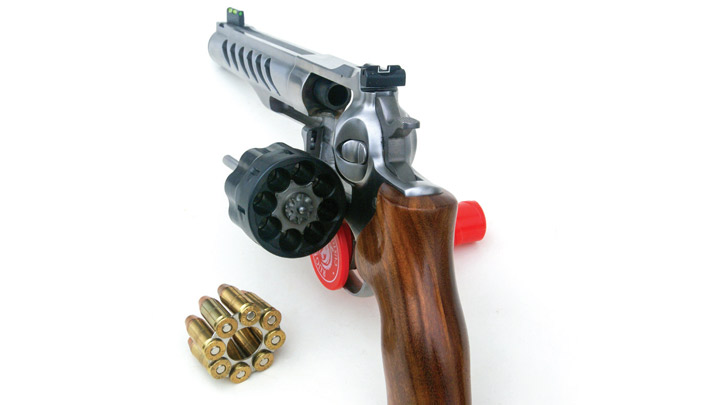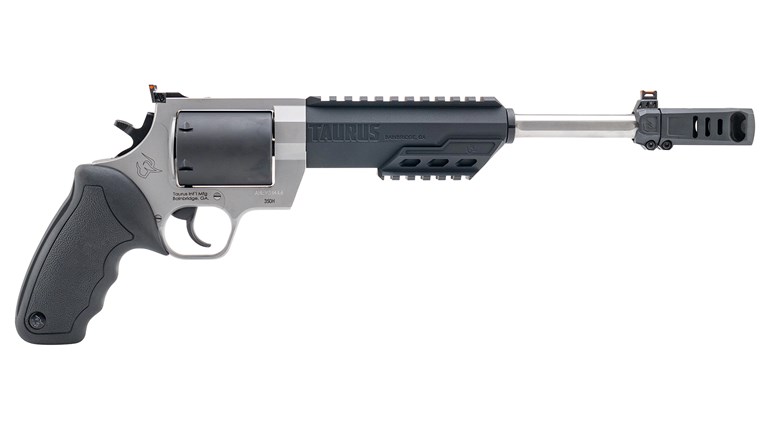
When the Ruger Custom Shop introduced its Super GP100 eight-shot .357 Mag. competition revolver in 2019 it was almost inevitable that a 9mm version would follow. That occurred in 2020 and should find favor with USPSA, Steel Challenge and ICORE shooters who favor an eight-shot moon-clip-fed 9mm wheelgun.

The Ruger Custom Shop Super GP100 9mm ($1,549, Ruger.com) is built on the same platform as the .357 Mag. There are many similarities as well as a few differences that go beyond the caliber.
Both are constructed from stainless steel, but while the .357 Mag. is fully finished in a dark-matte PVD finish, the 9mm only coats the cylinder—leaving the rest of the gun in a brushed stainless finish. A noticeable difference is that the 9mm model uses a shortened cylinder that reduces the bullet jump from chamber to forcing cone, which aids in accuracy. That reduced cylinder trims the 9mm gun weight to 45.06 ounces as compared to the 47 ounces of the .357 Mag.
Both guns feature a half-lug barrel with a scalloped barrel shroud and eight-groove rifling in a 1:16-inch right-hand twist with an 11-degree target crown. But, the 9mm uses a 6-inch barrel as opposed to the .357 Mag that sports a 5.5-inch one.

The sights are the same on both. The front sight is a replaceable fiber-optic rod in a 0.060 size (green was installed) and Ruger’s adjustable white outline in the rear. The grips are the smooth-finished Hogue wood models. I found the grips comfortable, but the Super GP100 will accept any grip for the standard GP100 and there are a lot of aftermarket options. The proper grips for the shooter’s hand are critical with a DA revolver and worth experimenting with.
From the box the DA trigger pull exceeded the 12-pound limit on my Lyman gauge. I estimated about 13 pounds, which is normal for factory revolvers. But it’s easy to reduce the trigger pull on the Super GP100 since it uses the same internal action and springs as the GP100. Inexpensive spring kits from Wolff Gunsprings or Wilson Combat, combined with a little polishing, will easily bring the DA pull down into the seven- to eight-pound range. However, dropping the pull weight that much will require shooters to emulate those reloading .38 Spl. and craft their ammunition with sensitive primers (like Federal) and seat them 0.006 to 0.008 below flush with the cartridge base. Factory ammunition would be problematic.
The gun ships in a waterproof, fitted hard case with three moon clips (additional clips are available from Ruger), a Custom Shop Certificate of Authenticity, challenge coin, cable lock, cleaning cloth, gun peg, Ruger decal and owner’s manual.
Ruger also includes a very nice demooning tool. It has a solid screwdrivertype handle and a hollow shaft with a lip on the upper end to keep cases from flipping out of the tool. Pop the empty cases out of the moon clip and they fall into the shaft. It holds nine 9mm cases and also works for .38 Spl., holding six of those. When the demooner is full of fired brass, just dump it into the brass container of your choice.

Range Time
Given the various roles this gun can play with differing Power Factors in USPSA, Steel Challenge, and ICORE, I assembled loads ranging from 100 to 147 grains. They included the Atlanta Arms 100-grain FMJ Steel Challenge, Blazer aluminum 115-grain, Federal’s 147-grain FMJ FP and my “Mouse Puff” 120-grain Bayou TCG handload. Since the 124-grain is one of the most popular bullet weights in 9mm I wanted two to test. I had Federal American Eagle 124 FMJ on hand, but lacked others. So, I purchased an inexpensive fresh 50-round box of Aguila 124 FMJ.
With only three moon clips, a match was out of the question. So, I zeroed the sights with the Federal 124-grain load and started with some Double Tap drills from the low ready at ranges from 10 to 25 yards. I cycled all the rounds through the three provided moon clips and was impressed at how fast the short 9mm rounds flew out of the gun on ejection. The trigger was also nicely rounded for DA work—after 100 rounds my trigger finger was still smiling at me.

Moving on to the accuracy tests, the accompanying chart clearly shows the 9mm Ruger Custom Shop GP100 revolver has more than enough accuracy with quality loads.
The last step was a trip to my club for their Wednesday Steel Challenge practice day. They set up four different stages, and you shoot them at your leisure. My Steel Challenge revolver shooting has been with my six-shot GP100, and despite the heavy trigger pull, the eight rounds on tap were fun. The two extra loads let me run faster, with two extra misses, before I had to decide whether it was “time worthwhile” to make a reload or just go to the Stop Plate. I could see some serious possibilities if I popped in a spring kit and dropped the trigger pull to the same 7.7 pounds that my GP100s have.
Accuracy Chart
All firing done from a 25-yard sandbag rest in single-action mode. Group size is the average of two full cylinder eight-round groups, reported in inches.
Load, Group Size (inches)
- Accurate Arms 100-grain Steel Challenge, 3.37
- Blazer (aluminum case) 115-grain FMJ, 3.79
- Bayou 120-grain TCG handload, 3.58
- Federal 124-grain American Eagle FMJ, 2.99
- Aguila 124-grain FMJ, 5.79
- Federal 147-grain American Eagle FMJ FP, 2.74
The only malfunctions that occurred in the approximately 350-round test were failures to fire with three of the Aguila 124 loads. One fired on the second try and the other two refused, even though the primer indent was normal. Given that all other rounds performed well in the supplied moon clips, I blame these hiccups on the ammunition and not the gun.
For those who favor a 9mm in a revolver, this gun requires nothing more than a spring kit to be ready for serious competition.
Learn more at Ruger.com.
Read more articles by Chris Christian:
- How To Get Started In Action Shooting
- Introduction To ICORE
- How To Deliver Accurate Hits On The Move
- Understanding USPSA Comstock and Virginia Count
- Review: Ruger Super GP-100
- Rimfire Rifles and Steel
- Review: SIG Romeo1 Pro
- Conquering Cataracts
- Review: Lapua 9mm 123-grain FMJ
- 5 Tips To Help You Win Trophies With A Revolver
- How To Master Tight Pistol Shots With The Focus Drill
- Review: Smith & Wesson M&P 15-22 Sport OR with Optic
- Spend Your Time Wisely: Economy Of Motion In Action Shooting
- Review: Federal Syntech PCC 9mm 130-Grain
- Wringing Out CCI’s New Clean-22 Rimfire Loads



































